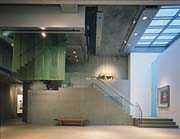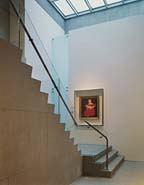
Recently, the American Folk Art Museum expanded its presence from the Lincoln Center in New York, to a building all its own in another part of the city. And when this occurred, it marked the first art museum to be built from the ground up in New York since 1966. The museum -- which holds a 4,000-piece collection spanning three centuries of American folk art, such as quilts and weathervanes -- is an 8-level, 85-foot-tall structure.
Since the building itself is significant, the design set by Tod Williams Billie Tsien Architects, also in New York, had to make the same impact. While the 29,000-square-foot building's exterior has a metallic facade, visitors are greeted with about 4,000 square feet of Pietre Piasentina limestone upon entering the ground floor. The floors, main staircase, caf?ountertops as well as a donor wall -- an 11- x 13-foot wall engraved with names of contributors to the museum -- are clad with limestone, which gives the stone a significant presence in the building.
"We chose the limestone because the coloring was quite nice," said Philip Ryan, assistant project architect at Tod Williams Billie Tsien Architects. "The veining in it is controllable, and we could get good sizes and thicknesses, with 4-inch-thick pieces being the largest."
Walker Zanger of Sylmar, CA, supplied the stone, in varying finishes. The floor was done in a flamed finish, the donor walls and countertops were honed and the walls had a thermal finish. "Because of its presence in the building, the challenge we faced was really to select the right stone," said Ryan. "[Members of the firm] went to Italy to pick the portions of stone, and we decided the limitations for the veining in the stone, and the coffee-like stains the stone has. It was crucial to set parameters in order to find a stone we could live with."

Once Walker Zanger received the containers of stone, there was no room to unload them on-site. Instead, the stone was taken to the warehouse of Port Morris Tile & Marble in the Bronx, NY, who delivered it by truck, and then installed the stone. "The floors were installed with a mud-bed, while the walls were installed using a brass wire and plaster anchoring system," said John Bertone, Jr. of Port Morris Tile & Marble. "We used sand and cement with Laticrete grout products."
About six to eight teams of three workers installed the stone over a four-to five-month period. "The only difficulty we had were the details around the stairs and stair walls," said Bertone. "We had to do a lot of coordination by hand - while we did the stair treads with mud-bed, the risers were anchored. We did a lot of field visits to work out the details, because everyone had to remain within the set tolerances."
In addition to the limestone, a 3-inch aggregate made up of Haverstraw traprock is also prevalent in the concrete found throughout the building. "All the concrete walls were finished with a bushhammer to expose the bluish-gray aggregate," said Ryan. "The limestone is a warm, brownish-gray tone, so it also went well with the concrete in the building," said Ryan.
When the museum opened in December 2001 - after being worked on since October 1999 - the stone fit into the design as well as the architects had anticipated. "We had wanted to maximize the spatial and functional use of the space," said Ryan. "The reaction to it has been very positive. It has gotten a lot of press, as there has been a renewed awareness in architecture since September 11 - it is a real gem on the street."
Since opening, the museum has won the National AIA award, a New York City AIA award, and World Architecture magazine honored it with its "Best Building in the World," the "Best Building in North America," and the "Best Cultural Building" awards.